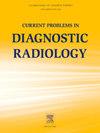儿童放射学:早期教育和工作场所志愿服务的好处。
IF 1.5
Q3 RADIOLOGY, NUCLEAR MEDICINE & MEDICAL IMAGING
引用次数: 0
摘要
目的:预计到2036年,医生短缺将影响卫生保健的所有领域。解决这一短缺的一个潜在方法是通过外联。我们描述了放射科如何开发和主办一个志愿者驱动的,沉浸式的儿童教育活动。方法:通过全部门电子邮件招募员工志愿者。两位放射科医生组织了这个项目,并安排获得成像设备进行演示。其他志愿者的任务是监督视听设备的使用,为讲习班提供便利,订餐和预订房间。支付一名工作人员支助活动后勤。在活动前后,学生参与者被要求完成可选的匿名调查,评估他们对放射学的知识、态度和行为。结果:为期半天的放射学教育活动包括2小时的教学讲座,随后是质量改进、现场超声检查、介入放射学和介入肿瘤学的实践体验。32名学生参加了活动(年龄中位数14岁[范围8-17岁]);其中21例(66%)是专职医疗人员的子女,11例(35%)是医生的子女。活动前调查回复率为94%;事件后反应率为63%。事后调查显示,表示“了解放射科医生的工作”的学生比例显著增加(从23%增加到55%;P= 0.01)和“[能]说出至少3种不同的模式”(从33%到70%;P = .02点)。活动结束后,学生和家长给予了热烈的反馈。结论:放射科发起的青年学习者教育项目获得了良好的反响,并为员工提供了多种志愿者和社交机会。总结句:部门赞助的志愿者活动,比如教育活动,可以对学生的成长和员工的敬业度和幸福感做出有意义的贡献。本文章由计算机程序翻译,如有差异,请以英文原文为准。
Radiology for kids: Benefits of early education and workplace volunteerism
Objective
Physician shortages are predicted to affect all fields of health care by 2036. One potential approach to address this shortage is through outreach. We describe how a radiology department developed and hosted a volunteer-driven, immersive educational event for children.
Methods
Staff volunteers were recruited though a department-wide email. Two radiologists organized the program and arranged to obtain imaging equipment for demonstrations. Other volunteers were tasked with overseeing audiovisual equipment use, facilitating workshops, ordering food, and reserving rooms. One staff member was paid to support event logistics. Before and after the event, student participants were asked to complete optional, anonymous surveys that assessed their knowledge, attitudes, and behavior toward radiology.
Results
The half-day radiology educational event consisted of 2 hours of didactic lectures, followed by hands-on experiences in quality improvement, point-of-care ultrasonography, interventional radiology, and interventional oncology. Thirty-two students attended the event (median age, 14 [range, 8-17] years); 21 (66%) were children of allied health employees, and 11 (35%) were children of physicians. The pre-event survey response rate was 94%; the postevent response rate was 63%. The postevent survey showed significant increases in the proportion of students who said they “[understood] what a radiologist does” (from 23% to 55%; P=.01) and “[could] name at least 3 different modalities” (from 33% to 70%; P=.02). Students and their parents gave enthusiastic feedback after the event.
Conclusion
A radiology department–sponsored educational program for young learners was well received and provided multiple volunteer and socialization opportunities for employees.
Summary sentence
Department-sponsored volunteer events, such as an educational event, can meaningfully contribute to student growth and employee engagement and well-being.
求助全文
通过发布文献求助,成功后即可免费获取论文全文。
去求助
来源期刊

Current Problems in Diagnostic Radiology
RADIOLOGY, NUCLEAR MEDICINE & MEDICAL IMAGING-
CiteScore
3.00
自引率
0.00%
发文量
113
审稿时长
46 days
期刊介绍:
Current Problems in Diagnostic Radiology covers important and controversial topics in radiology. Each issue presents important viewpoints from leading radiologists. High-quality reproductions of radiographs, CT scans, MR images, and sonograms clearly depict what is being described in each article. Also included are valuable updates relevant to other areas of practice, such as medical-legal issues or archiving systems. With new multi-topic format and image-intensive style, Current Problems in Diagnostic Radiology offers an outstanding, time-saving investigation into current topics most relevant to radiologists.
 求助内容:
求助内容: 应助结果提醒方式:
应助结果提醒方式:


